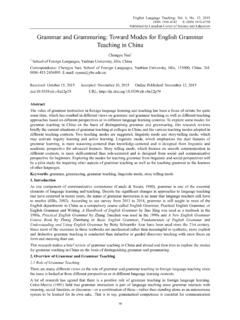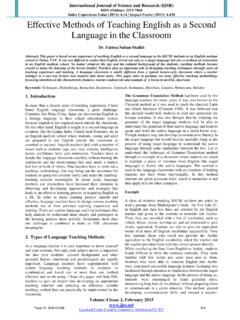Transcription of Developing the macro skills in a competence based curriculum
1 Developing the macro skills in a competence based curriculum 1 Developing the macro skills in a competence based curriculum 2 Developing listening and speaking skills in a competence based curriculum When we learn a language, there are four skills that we need for complete communication. When we learn our native language, we usually learn to listen first, then to speak, then to read, and finally to write. These are called the four "language skills ": also known as " macro skills ' macro skills are most commonly referred to listening, speaking, reading and writing in English language. Listening: This is a communication technique that requires the listener to understand, interpret and evaluate what he or she hears.
2 Listening effectively improves personal relationships through the reduction of conflict and strengthens cooperation through a collective understanding while speaking is vocalization of human communication. Being able to express an idea, concept or opinion through speech is essential in the communicative process and languages are about communication. A good language teachers plan lessons, and sequences of lessons, which include a mixture of all the macro - skills , rather than focusing on Developing only one macro -skill at a time. Listening is the most important skill in communication. It is a mental operation involving processing sound waves, interpreting their meaning, and storing them in memory. It is a communication technique that requires the listeners to understand, interpret, and evaluate what they hear.
3 It paves the way for other skills to tower over the others because of its significance in terms of speech, discussion and freedom of expression. They serve as an approach to make everybody comprehend which is being said. It is closely related to Developing the macro skills in a competence based curriculum 3 speaking and it enables the persons to soak in any information that is given to them; consequently, the information can be passed on to another party later on after the conversation. On the other hand, learners will develop prediction and anticipation skills in listening. Without listening, communication will be crippled. It is vital and should be a main part in communication. Second language (L2) listening comprehension is a complex process, crucial in the development of second language competence .
4 Listeners use both bottom-up processes (linguistic knowledge) and top-down processes (prior knowledge) to comprehend. Knowing the context of a listening text and the purpose for listening greatly reduces the burden of comprehension. This will help students learn how to listen and develop the metacognitive knowledge and strategies crucial to success in listening comprehension. Listening strategies are techniques or activities that contribute directly to the comprehension and recall of listening input. Listening strategies can be classified by how the listener processes the input. Top-down strategies are listener based ; the listener taps into background knowledge of the topic, the situation or context, the type of text, and the language. This background knowledge activates a set of expectations that help the listener to interpret what is heard and anticipate what will come next.
5 Top-down strategies include listening for the main idea predicting drawing inferences summarizing Bottom-up strategies are text based ; the listener relies on the language in the message, that is, the combination of sounds, words, and grammar that creates meaning. Bottom-up strategies include listening for specific details recognizing cognates recognizing word-order patterns Research has demonstrated that adults spend 40-50% of communication time listening (Gilman & Moody 1984), but the importance of listening in language learning has only been recognized relatively recently (Oxford 1993). Since the role of listening comprehension in language learning was taken for granted, it merited little research and pedagogical attention. Although listening played an important role in audio - lingual methods, students only listened to repeat and develop a better pronunciation (for speaking).
6 Developing the macro skills in a competence based curriculum 4 Beginning in the early 70's, work by Asher, Postovsky, Winitz and, later, Krashen, brought attention to the role of listening as a tool for understanding and a key factor in facilitating language learning. Listening has emerged as an important component in the process of second language acquisition (Feyten, 1991). This research base provides support for the pre-eminence of listening comprehension in instructional methods, especially in the early stages of language learning. You should know that there are different types of listening: Listening for gist: you listen in order to understand the main idea of the text. Listening for specific information: you want to find out specific details, for example key words.
7 Listening for detailed understanding: you want to understand all the information the text provides. SUGGESTIONS FOR IMPROVING YOUR LISTENING skills Before you listen Think about the topic of the text you are going to listen to. What do you already know about it? What could possibly be the content of the text? Which words come to mind that you already know? Which words would you want to look up? If you have to do a task on the listening text, check whether you have understood the task correctly. Think about what type of text you are going to listen to. What do you know about this type of text? Relax and make yourself ready to pay attention to the listening text. While you are listening It is not necessary to understand every single word. Try to ignore those words that you think are less important anyway.
8 If there are words or issues that you don't understand, use your general knowledge as well as the context to find out the meaning. If you still don't understand something, use a dictionary to look up the words or ask someone else for help. Focus on key words and facts. Take notes to support your memory. Intonation and stress of the speakers can help you to understand what you hear. Try to think ahead. What might happen next? What might the speakers say, which words might they use? After listening Think about the text again. Have you understood the main points? Remember the speculations you made before you listened. Did they come true? Review your notes. understand the main idea of the text. Listening for specific information: you want to find out specific details, for example key words.
9 Listening for detailed understanding: you want to understand all the information the text provides. Developing the macro skills in a competence based curriculum 5 Check whether you have completed your task correctly. Have you had any problems while listening? Do you have any problems now to complete your task? Identify your problems and ask someone for help. Listen again to difficult passages. Thanks to Here are some activities you can introduce in class for active listening with integration with other skills Dual dictation Ask students to get into pairs to write a dialogue. When student A is speaking, student B should write down what they are saying and vice versa. When they have finished the conversation, they should check what each other has written and put the two sides of the conversation together.
10 You could then ask students to perform their dialogues again to the rest of the class, or to swap with other pairs. This activity works best if you give students a theme or role-play, A conversation between friends about holidays An argument between siblings An interview with a famous person A scene from a film Class memory quiz Ask one student at a time to go to the front of the class. Ask the rest of the class to ask them any questions they like (as long as they are not too personal!), What is your favourite colour/food/band? What did you have for lunch? Which country would you most like to visit? Try to make a note of some of the answers. When all of the students (or half of the students, if you have a large group) have been interviewed, explain that you are going to hold a quiz about the class.

